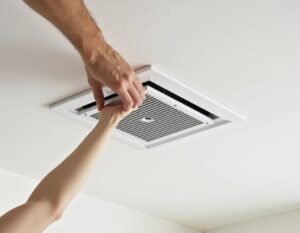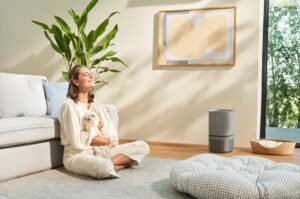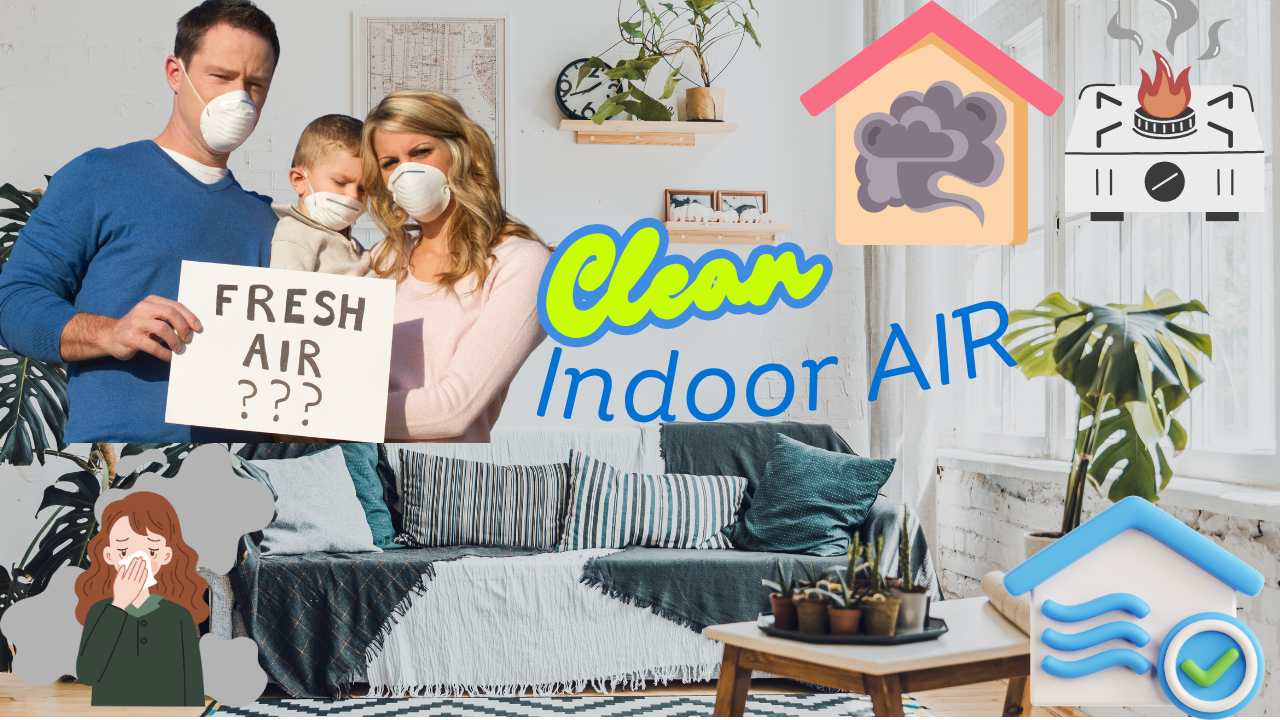Breathe Easy: Your Simple Guide to Cleaner, Healthier Home & Office Air
Did you know the air inside your home or office is often 2-5 times more polluted than outdoor air? Even more startling: the average American spends a whopping 90% of their time indoors 8. This makes indoor air quality (IAQ) a critical, yet often overlooked, factor in your health, comfort, and productivity.
Poor indoor air isn’t just about stuffiness. It’s linked to headaches, fatigue, allergies, asthma flare-ups, difficulty concentrating, and even serious long-term health problems like heart disease and lung cancer. The good news? Taking control of your indoor air is achievable with simple steps.
Why Indoor Air Quality Matters: The Hidden Pollutants
Common indoor air pollutants are often invisible, but their effects are real. Here’s a look at the main culprits:
-
Particulate Matter (PM2.5/PM10): Tiny particles from dust, pollen, pet dander, cooking smoke, and outdoor pollution. They penetrate deep into lungs and even the bloodstream, triggering allergies, asthma, and cardiovascular issues.
-
Volatile Organic Compounds (VOCs): Gases emitted from everyday products like paints, cleaning chemicals, air fresheners, furniture, carpets, glues, and printers. They cause eye/nose/throat irritation, headaches, nausea, and some are carcinogenic (like formaldehyde)
-
Radon: A radioactive gas seeping from the ground into basements. It’s the second leading cause of lung cancer in the US .
-
Carbon Monoxide (CO): A deadly, odorless gas from faulty fuel-burning appliances (furnaces, water heaters, generators, cars in garages) .
-
Biological Contaminants: Mold, mildew, bacteria, viruses, dust mites, and pet allergens. Thrive in damp conditions and cause respiratory infections, allergies, and asthma .
-
Carbon Dioxide (CO2): Buildup from exhaled breath in poorly ventilated spaces. High levels cause drowsiness, poor concentration, and headaches .
Table 1: Common Indoor Air Pollutants & Their Sources
| Pollutant | Major Sources Inside Your Home/Office | Key Health Concerns |
|---|---|---|
| Particulate Matter | Cooking, smoking, dusting, pets, outdoor air, fireplaces, candles | Asthma, allergies, heart disease, lung irritation |
| VOCs | Cleaning products, paints, air fresheners, new furniture, carpets, printers | Eye/nose/throat irritation, headaches, nausea, cancer risk |
| Radon | Soil under buildings (enters through cracks) | Lung cancer |
| Carbon Monoxide | Faulty furnaces, water heaters, gas stoves, idling cars in garages | Headaches, dizziness, death |
| Biologicals | Damp areas, leaks, humidifiers, pets, plants (overwatered), dust | Allergies, asthma, infections |
| Carbon Dioxide | Occupants breathing, poor ventilation | Drowsiness, poor concentration, headaches |
How to “Check” Your Indoor Air Quality (Without Being a Scientist)

You don’t need a lab coat! Here’s how to assess your air:
-
Use Your Senses:
-
Smell: Persistent musty odors suggest mold. Chemical smells point to VOCs. Stale air indicates poor ventilation.
-
Sight: Visible mold growth, excessive dust buildup on surfaces/vents, or yellowing near gas appliances are red flags. Condensation on windows signals high humidity.
-
Feel: Experience frequent headaches, congestion, itchy eyes, or fatigue, especially at home or arriving at the office? Your air could be the culprit.
-
-
Invest in Simple Monitors (The Easy Way):
-
Radon Test Kits: Inexpensive, short-term (2-7 day) or long-term (90+ day) kits available online or hardware stores. Essential for basements and ground floors. 113
-
Carbon Monoxide Detectors: Non-negotiable safety devices! Install near sleeping areas and fuel-burning appliances. Test batteries annually.
-
Indoor Air Quality Monitors: Devices like the Airthings View Plus track multiple factors in real-time (PM2.5, VOCs, CO2, humidity, temp, radon – though radon requires 30 days calibration). They provide app data and visual alerts (green/yellow/red). Other good options focus on specific concerns like CO2 (SAF Aranet 4) 16. Note: Cheaper monitors can be unreliable, especially for VOCs.
-
-
Check Outdoor Air Quality: Outdoor pollution significantly impacts indoor air. Use the EPA’s free AirNow app (iOS/Android) to see local PM2.5, ozone, etc. If it’s bad outside, keep windows closed and rely on filtration.
Simple, Effective Ways to Keep Your Indoor Air Clean & Healthy
Improving IAQ focuses on three core strategies: Source Control, Ventilation, and Cleaning/Filtration.
-
Strike at the Source (Most Effective!):
-
Ban Indoor Smoking: Absolutely no tobacco products indoors.
-
Ditch Harsh Chemicals: Replace aerosol sprays, bleach-based cleaners, and synthetic air fresheners with low-VOC, plant-based (botanical) alternatives or simple solutions like vinegar and baking soda. Look for “plant-based,” “bio-based,” or “botanical extract” labels.
-
Control Moisture & Prevent Mold: Fix leaks immediately. Use exhaust fans in bathrooms/kitchens. Keep indoor humidity between 30-50% (use a dehumidifier if needed). Clean small mold patches with soap/water; hire pros for large infestations.
-
Maintain Fuel-Burning Appliances: Get furnaces, water heaters, fireplaces, and chimneys inspected and cleaned by a qualified professional yearly. Ensure proper venting. Never idle cars or run gas-powered tools (mowers, generators) in attached garages.
-
Choose Low-Emission Furnishings: When buying new furniture, carpets, or paints, look for low-VOC or no-VOC options. Let new items off-gas in a garage or well-ventilated area before bringing them inside.
-
Reduce Clutter & Choose Cleanable Surfaces: Clutter collects dust. Declutter and opt for non-porous materials (glass, metal, sealed tile/stone) for easier cleaning and less moisture retention 213. Vacuum frequently (HEPA filter vacuum preferred) and damp-dust.
-
-
Ventilate, Ventilate, Ventilate (Let Fresh Air In):

-
Open Windows (Strategically): When outdoor air quality is good (check AirNow!), open windows for at least 10 minutes daily, even in winter. Cross-ventilation (windows on opposite sides) is best. Avoid opening windows near busy roads or during high pollen/pollution days.
-
Use Exhaust Fans: Always turn on the kitchen exhaust hood (use the highest setting tolerable) while cooking, especially frying or boiling. Run bathroom fans during and for 20-30 minutes after showers. Ensure fans vent outside, not just into the attic.
-
Consider Advanced Ventilation: If building or renovating, explore mechanical systems like Heat Recovery Ventilators (HRVs) or Energy Recovery Ventilators (ERVs). They bring in fresh air while minimizing energy loss by transferring heat/coolness between incoming and outgoing air streams.
-
-
Clean the Air You Breathe (Filtration):
-
Upgrade Your HVAC Filter: Use a filter with a MERV 13 rating (or the highest your system allows without restricting airflow). Change it regularly (check manufacturer’s instructions, often every 1-3 months).
-
Use Portable Air Purifiers: Place HEPA air purifiers in key areas like bedrooms and living rooms. Choose units sized appropriately for the room. HEPA filters are highly effective at capturing particles (dust, pollen, dander, some mold spores/bacteria). For gas/VOC removal, look for units with substantial activated carbon filters. Avoid ozone generators!
-
Houseplants: While beautiful, studies show you’d need an unrealistic number of plants to significantly reduce pollutants. They primarily offer psychological benefits. Don’t rely on them for air cleaning, and avoid overwatering to prevent mold.
-
Absorption of Pollutants: Through tiny openings in their leaves (stomata), plants absorb gaseous pollutants like formaldehyde, benzene, and xylene. These compounds are then broken down within the plant or by microorganisms in the soil
-
Humidity Regulation: Plants release water vapor through transpiration, increasing relative humidity. This can reduce respiratory irritation and dry skin, especially in heated or air-conditioned spaces 513. Plants like Boston Ferns are particularly effective natural humidifiers
-
Effective Air-Purifying Houseplants & Their Capabilities

Plant Name Key Pollutants Removed Special Notes Care Level Snake Plant (Sansevieria/Mother-in-Law’s Tongue) Formaldehyde, Benzene, Toluene, Xylene, Trichloroethylene 5914 Emits oxygen at night 💤; highly drought-tolerant ☀️; toxic to pets 🐾 ★☆☆ (Easy) Peace Lily (Spathiphyllum) Ammonia, Formaldehyde, Benzene, Trichloroethylene, Xylene 5914 Beautiful white flowers 🌸; increases humidity; toxic to pets 🐾 ★★☆ (Medium) Spider Plant (Chlorophytum comosum) Formaldehyde, Xylene, Carbon Monoxide 3514 Extremely easy to grow & propagate; safe for pets ✅ ★☆☆ (Easy) Boston Fern (Nephrolepis exaltata) Formaldehyde, Xylene, Toluene, Benzene, Cigarette Smoke 5914 Excellent natural humidifier 💧; non-toxic to pets ✅ ★★★ (Higher – needs humidity) English Ivy (Hedera helix) Benzene, Formaldehyde, Trichloroethylene, Airborne Fecal Matter 3514 Effective in bathrooms 🛁; trailing habit; toxic to pets 🐾 ★★☆ (Medium) Bamboo Palm (Chamaedorea seifrizii) Formaldehyde, Benzene, Carbon Monoxide 914 Adds tropical feel 🌴; non-toxic to pets ✅ ★★☆ (Medium – needs regular water) Dracaena (Various species like ‘Janet Craig’, ‘Warneckii’) Formaldehyde, Trichloroethylene, Benzene 349 Very effective (removes up to 70% formaldehyde in 24hrs ⏱️); toxic to pets 🐾 ★★☆ (Medium) Chrysanthemum (Florist’s Mum) Formaldehyde, Benzene, Xylene, Ammonia 3514 Beautiful seasonal flowers 🌼; toxic to pets 🐾 ★☆☆ (Easy) Golden Pothos (Epipremnum aureum) Formaldehyde, Benzene, Xylene, Toluene 4914 Very hardy trailing plant; grows well in low light 💡; toxic to pets 🐾 ★☆☆ (Easy) Aloe Vera Formaldehyde (from detergents, paints, glues) 5 Releases oxygen at night 💤; gel has healing properties; safe for humans (toxic in large amounts to pets) 🐾 ★☆☆ (Easy) 📍 Strategic Placement for Maximum Benefit
Where you place plants significantly impacts their effectiveness:
-
Bedrooms: Snake Plants, Orchids, Lavender, or Peace Lilies. Plants emitting oxygen at night (like Snake Plants, Orchids) can subtly improve sleep air quality. Lavender’s scent promotes relaxation 13.
-
Kitchens: Rosemary, Spider Plants, English Ivy, Aloe Vera. Target VOCs from cleaning products, cooking fumes, and adhesives. Rosemary also neutralizes odors and is culinary-friendly 13.
-
Bathrooms: Boston Fern, English Ivy, Pothos, Orchids. Combat mold-promoting humidity and VOCs from personal care products. Ivy specifically reduces airborne fecal matter 514.
-
Living Rooms/Offices: Peace Lily, Dracaena, Bamboo Palm, Chrysanthemum, Rubber Plant. Ideal for larger spaces with furniture emitting formaldehyde. Place near desks (Peace Lily) or sofas (Bamboo Palm).
-
Near Entryways/Windows: Gerbera Daisies, Chrysanthemums. Help filter pollutants entering from outdoors 414.
-
-
-
Table 2: Top Action Plan for Better Indoor Air Quality
| Strategy | Key Actions | Frequency/Notes |
|---|---|---|
| Source Control | Eliminate indoor smoking; Switch to low-VOC cleaners/products; Fix leaks; Control humidity (30-50%); Maintain fuel-burning appliances | Immediate & Ongoing; Yearly appliance servicing |
| Ventilation | Open windows when outdoor air good; Run kitchen/bath exhaust fans; Consider HRV/ERV systems | Daily (windows/fans); During/after cooking/showering |
| Filtration | Use MERV 13 HVAC filters; Run portable HEPA + Carbon air purifiers in key rooms | Change filters per manual (1-3 mo); Purifiers run often |
| Monitoring | Install CO detectors; Test for radon; Use IAQ monitor (optional) | Test CO monthly; Radon test every 2 years; Monitor as needed |
Building Healthy Habits for Long-Term Air Quality

-
Cook Smart: Always use your range hood on high, especially for frying. Cover pots to reduce moisture and particles. Prefer back burners under the hood.
-
Clean Regularly: Vacuum carpets/rugs (HEPA vacuum best), damp-mop hard floors, and wash bedding weekly in hot water to combat dust mites. Ensure dryer vents outside and clean lint traps.
-
Be Mindful of Hobbies: Painting, sanding, woodworking, or using strong adhesives? Do these activities in well-ventilated areas (ideally outdoors or with windows open and fans running). Wear appropriate masks.
-
Minimize Burning: Limit use of candles (especially paraffin), incense, and wood-burning fireplaces. Never use unvented gas or kerosene heaters indoors.
-
Check Detectors: Test smoke and carbon monoxide detectors monthly and replace batteries annually.
Breathe Easy, Live Healthier
Taking charge of your indoor air quality isn’t about perfection; it’s about making consistent, manageable changes. By focusing on reducing pollutant sources, bringing in fresh air strategically, and cleaning the air effectively, you can transform your home or office into a healthier haven. The benefits – fewer allergies, better sleep, sharper focus, and reduced long-term health risks – are well worth the effort. Start small, pick one or two strategies from this guide, and breathe easier knowing you’re creating a cleaner environment for yourself and those around you.
Frequently Asked Questions (FAQs)
-
What’s the single best thing I can do for indoor air? Ventilate! Open windows when outdoor air is clean (check AirNow) for at least 10 minutes daily. If outdoor air is bad, focus on source control and filtration.
-
Do air purifiers really work? Yes, for specific pollutants. HEPA purifiers are excellent for particles (dust, pollen, dander). Purifiers with substantial activated carbon filters help reduce VOCs and odors. They are most effective when used alongside source control and ventilation. Avoid ozone generators.
-
Are houseplants good for air quality? Their impact is very limited. While they look nice, you’d need an impractical number of plants to noticeably reduce pollutants. They shouldn’t be your primary air cleaning strategy. Avoid overwatering to prevent mold growth.
-
How often should I test for radon? The EPA recommends testing homes every 2 years. Test basements and ground floors first. Use certified short-term or long-term test kits. Mitigation is needed if levels are 4 pCi/L or higher.
-
Why does my monitor show high VOCs sometimes? VOC spikes are common during/after activities like cleaning with chemicals, painting, cooking, using air fresheners or scented candles, bringing in new furniture, or even printing. Increase ventilation during and after these activities. Choose low-VOC products. Note that cheaper monitors can give false readings; higher-end models (like Airthings) are more reliable but need calibration time (about a week for VOCs/CO2).












